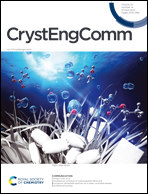Study on the trace moisture influence on the adhesion phenomenon in Cd-based crystal growth
Abstract
The wetting and sticking phenomena are the principal factors that lead to dislocation, parasitic grain nucleation, cracking, and other issues during crucible-based crystal growth of Cd-based crystals (CdTe/Cd1−xZnxTe). The trace amount of moisture in raw materials is an important factor influencing the sticking process, but this has not been sufficiently studied. Here, we investigate the chemical reactions between trace moisture and raw Cd materials by introducing H2O intentionally. The X-ray photoelectron spectra of the sticky surface indicate that residual moisture can react with raw Cd and generate more CdO compared with the untreated Cd. The reactive gas atmosphere process (RAP) method with a self-designed crucible was modified for the removal of moisture and reaction products. The waste products of the RAP method were successfully separated and determined to be CdCl2, CdCO3, CdO, and SiO2. The whole chemical process of oxidation and the RAP method was proposed accordingly. The purified Cd showed a spherical shape derived from the surface tension and de-wetting with the bare quartz crucible. These studies provide a comprehensive description of the moisture-driven oxidation behavior of Cd responsible for the sticking problem of the Cd/SiO2 system, which may guide high-quality Cd-based crystal growth techniques.



 Please wait while we load your content...
Please wait while we load your content...